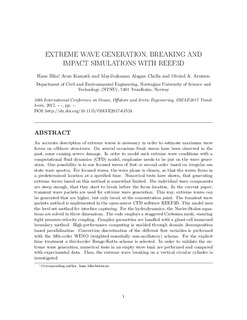| dc.contributor.author | Bihs, Hans | |
| dc.contributor.author | Kamath, Arun | |
| dc.contributor.author | Alagan Chella, Mayilvahanan | |
| dc.contributor.author | Arntsen, Øivind Asgeir | |
| dc.date.accessioned | 2018-02-19T09:45:21Z | |
| dc.date.available | 2018-02-19T09:45:21Z | |
| dc.date.created | 2017-09-28T18:41:01Z | |
| dc.date.issued | 2017 | |
| dc.identifier.isbn | 978-0-7918-5764-9 | |
| dc.identifier.uri | http://hdl.handle.net/11250/2485584 | |
| dc.description.abstract | An accurate description of extreme waves is necessary in order to estimate maximum wave forces on offshore structures. On several occasions freak waves have been observed in the past, some causing severe damage. In order to model such extreme wave conditions with a computational fluid dynamics (CFD) model, emphasize needs to be put on the wave generation. One possibility is to use focused waves of first or second order based on irregular sea state wave spectra. For focused waves, the wave phase is chosen, so that the waves focus in a predetermined location at a specified time. Numerical tests have shown, that generating extreme waves based on this method is somewhat limited. The individual wave components are steep enough, that they start to break before the focus location. In the current paper, transient wave packets are used for extreme wave generation. This way, extreme waves can be generated that are higher, but only break at the concentration point. The transient wave packets method is implemented in the open-source CFD software REEF3D. This model uses the level set method for interface capturing. For the hydrodynamics, the Navier-Stokes equations are solved in three dimensions. The code employs a staggered Cartesian mesh, ensuring tight pressure-velocity coupling. Complex geometries are handled with a ghost cell immersed boundary method. High-performance computing is enabled through domain decomposition based parallelization. Convection discretization of the different flow variables is performed with the fifth-order WENO (weighted essentially non-oscillatory) scheme. For the explicit time treatment a third-order Runge-Kutta scheme is selected. In order to validate the extreme wave generation, numerical tests in an empty wave tank are performed and compared with experimental data. Then, the extreme wave breaking on a vertical circular cylinder is investigated. | nb_NO |
| dc.language.iso | eng | nb_NO |
| dc.publisher | American Society of Mechanical Engineers (ASME) | nb_NO |
| dc.relation.ispartof | ASME 2017 36th International Conference on Ocean, Offshore and Arctic Engineering - Volume 2: Prof. Carl Martin Larsen and Dr. Owen Oakley Honoring Symposia on CFD and VIV | |
| dc.title | Extreme Wave Generation, Breaking and Impact Simulations With REEF3D | nb_NO |
| dc.type | Chapter | nb_NO |
| dc.description.version | acceptedVersion | nb_NO |
| dc.identifier.doi | 10.1115/OMAE2017-61524 | |
| dc.identifier.cristin | 1499982 | |
| dc.description.localcode | © 2017. This is the authors' accepted and refereed manuscript to the article. The final authenticated version is available online at: http://dx.doi.org/10.1115/OMAE2017-61524 | nb_NO |
| cristin.unitcode | 194,64,91,0 | |
| cristin.unitname | Institutt for bygg- og miljøteknikk | |
| cristin.ispublished | true | |
| cristin.fulltext | postprint | |
| cristin.qualitycode | 1 | |
